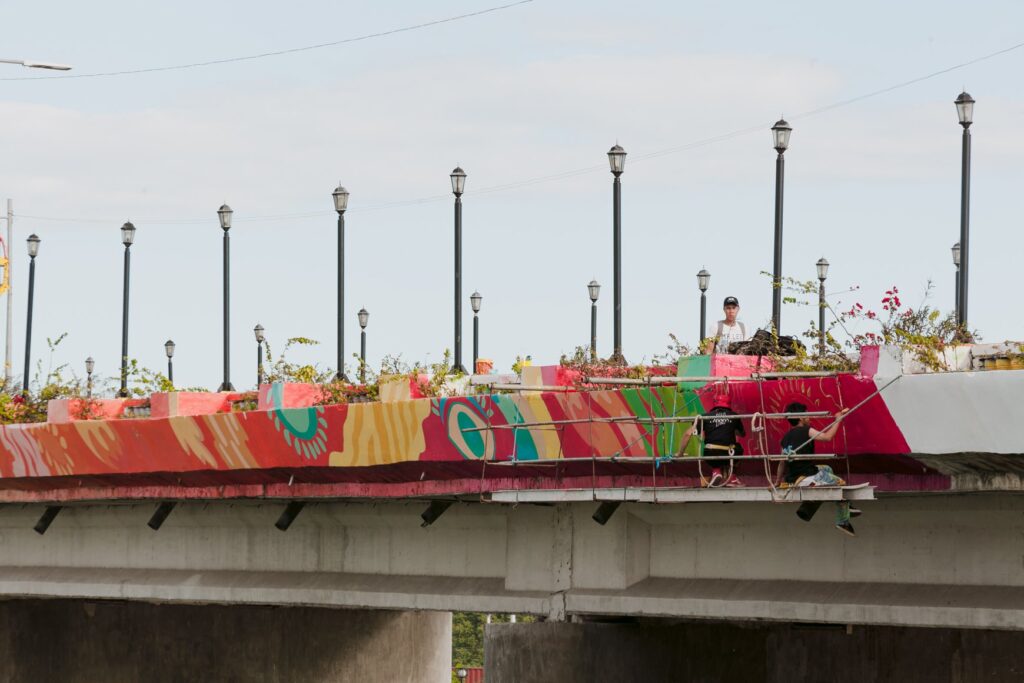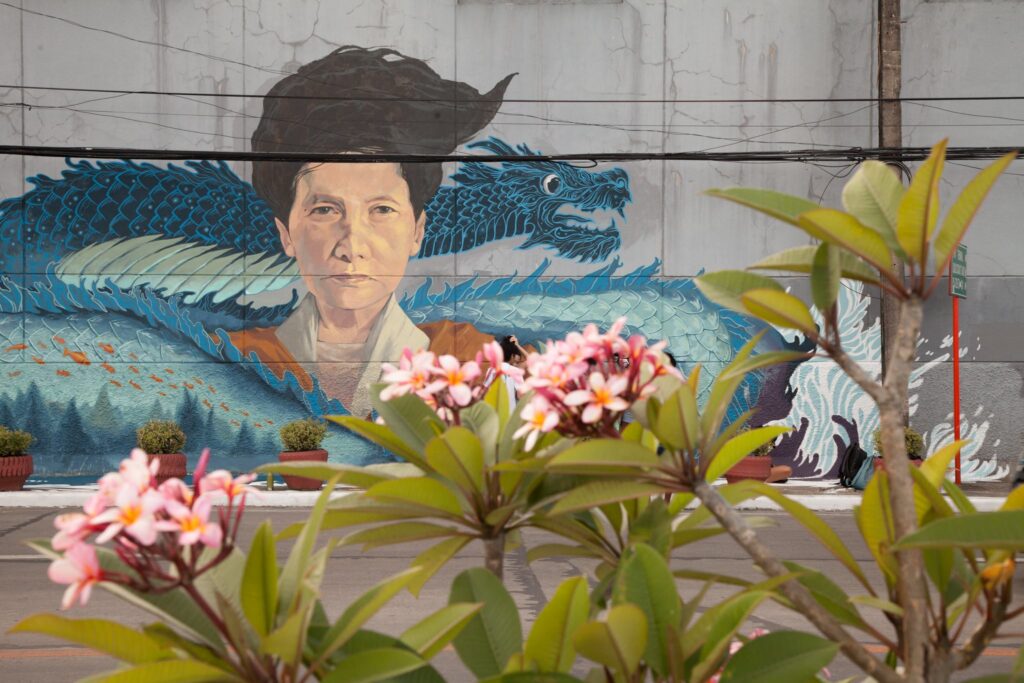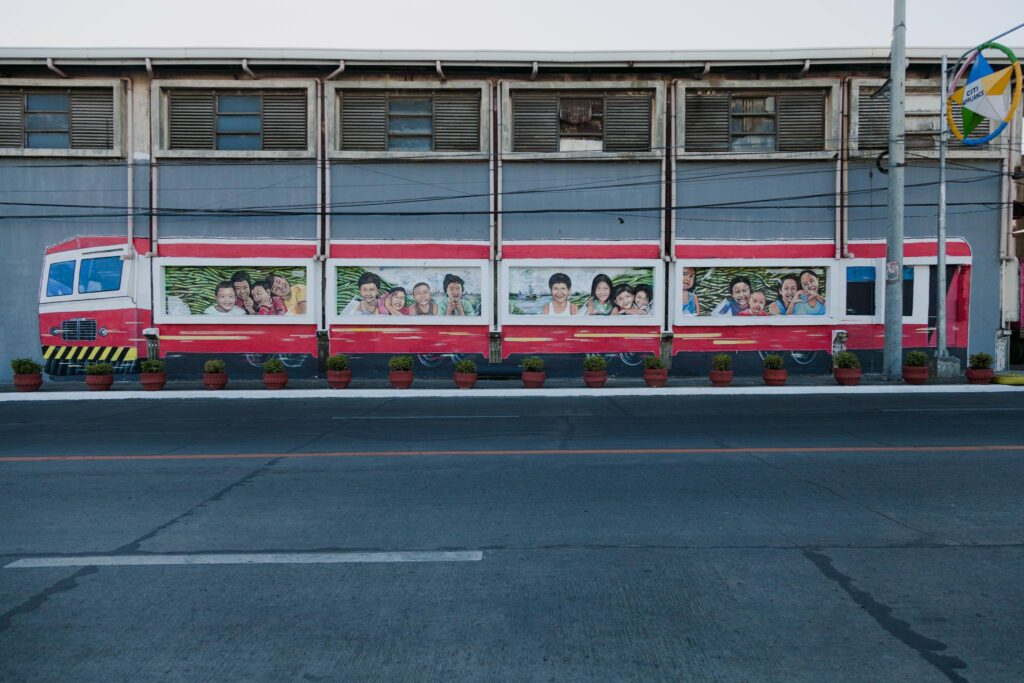The taxi I was riding passed by the Diversion Bridge, I asked the driver what he thinks about the colors that now envelope the bridge, and he replied “ano poblema sa puti nga pinta haw?” referring to the previous color of the bridge. The previous day, photos of the colorful bridge were heavily shared on social media with people saying they were impressed by the effort of the city to integrate art into public infrastructures. With the number of murals, installations, and graffiti sprouting in many streets of the city, let us examine how Iloilo became a canvas for artists who are finding spaces and venues to create and how they affect the community.

Public walls as alternative art space
In Iloilo, there are spaces dedicated to art. There’s the Iloilo Museum of Contemporary Art which houses a huge collection of artwork by contemporary Filipino artists, Museo Iloilo which hosts regular exhibitions featuring artists from all over Panay, and there are spaces that display art as a means to increase customers (cafes, diner, bistros, etc). Space used to be a problem for Ilonggo artists, and it may still be because of the politics that surrounds running an art space. But the Ilonggo artists are persistent in taking public spaces as an alternative exhibition venue for their artworks.
Murals have breathed new life into walls, especially in the old commercial business area. The old buildings along Solis St. to Muelle Loney feature mural-filled walls. Walking in the area feels like walking in an open-air gallery, complete with the hubbub of the vehicles and the crashing of waves on the seawalls as ambient music. What makes the streets a different art-appreciation experience is that the artworks are in some kind of stasis and the audience is in a constant state of flux. Pedestrians walk past them. The public has varied ways of interacting with them. And often in a spontaneous manner.
Perhaps the artists are drawn to using walls for the exhibition because of its collaborative nature. An artist group or a collective can work together in making one artwork. Some artists welcome a healthy harmony of ideas. Some artists enjoy the fellowship that doing artwork together creates. Aside from the artists collaborating with each other, creating murals is also a means of collaborating with the community.
Freedom walls
Murals are often seen in movements across the globe as means to raise awareness for social change that artivism a portmanteau of the word art and activism, has been coined by artists and writers. From graffiti to street art, public art always poses a call to action. Artivism Iloilo is a group of artists whose battle cry is to promote awareness of environmental issues. Their murals feature endangered species, depiction of effects of humans on the environment, the romanticization of nature, etc. They also organize events like gigs, mini art fairs, and other performances whenever they paint walls. Partnering with many environmental organizations, Artivism Iloilo has positioned itself as an environmental art group using murals as its main form of activism. Other public art with messages related to social issues include tributes to healthcare workers and other frontliners during the pandemic.

Visualizing Ilonggo Identity
Perhaps most of the prominent themes of murals in Iloilo City are the depiction of the Ilonggo identity including food, important figures, religion, flora and fauna among others. Looking at all these murals the artists seem to create the Ilonggo iconography. Along Muelle Loney, a towering depiction of Graciano Lopez-Jaena sits on the wall of the pumping station, he looks pensive, the narrow arm of the sea as his background. “Propagandist” is a mural by Kristoffer Brasileño, Jester Macabanti and Larry Vido. A few steps away is another portrait of a hero. ”Si Magbanua kag ang Bakunawa” is a crossover of a real-life hero and mythical figure painted by artists, Isaac Bravo, Sasha Cabais, Marrz Capanang, Marge Chavez, Stevenson Cordova, Akashi Seijūrō, Kyle Francis Dile, Epalan Noel, and Schunt Sotelo (Artivism Iloilo). The Bakunawa coils around the chest of Magbanua, her face looking strong as history accounts made her, she faces the sea.
Beyond Iloilo’s historical figures, Sigahum Group of Artists reminisces the time of the Philippine Railway Company which used to pass by Muelle Loney until it stopped operating in 1983. The windows of Sigahum’s ”Smile Train” burst with excitement in the faces of the kids, the kind you see in many arrivals and reunions.
One of the constant inspirations of murals in Iloilo City is the Indigenous People’s culture. Mia Reyes’ “Binanog Dance” in Atria gracefully intrigues the visitors of the commercial park. An image of a banog or hawk and a Panay Bukidnon woman dancing as if mimicking the flight of the bird. While Archie Oclos, “The Last Binukot”, an image of Binukot/former Binukot, is tucked in the corner of Solis St. downtown as if a metaphor for the marginalization that challenged the Panay Bukidnon people.
From paintings, Himbon, an artist group, added bas relief to make warriors dance in their “Dagyang Iloilo” mural. The statue of the warriors blends in with their painting counterparts giving the illusion of movement to the audience. The city government had a wall made in Esplanade I entrance to accommodate this artwork.
These murals along with other murals in the city capture the values of the people, how they honor history, how they give importance to the indigenous culture, how they creatively express their opinions, etc.

Putting the public in Public Art
Part of the reason why there is an increase in the number of murals in the city is the support that the artists are getting from the Iloilo City government. And as such, the public has become part of the equation. Beyond the hundreds of selfies and photos taken with the murals as the background, what are the ways that these artworks impact the audience? Do tourists intentionally visit the city because of them? Does it cause a shift in the perception of the people from art is elitist to art is inclusive? Does activism on walls translate to the movement on the ground? These impacts may be difficult to measure. But right now, there are people like the taxi driver who need context on why it could be a good thing that the bridges are now colorful.
A longer version of this review is included in the Iloilo Art Review 2022. Get your copy below.
